#history of the Yoruba people
Explore tagged Tumblr posts
Text
A History Of The Yoruba People
youtube
19 notes
·
View notes
Text
Yoruba Door Wood Carvings: The Artistic Tradition and Cultural Significance
The Yoruba door holds within its intricate wood carvings a rich tapestry of history and tradition, offering a fascinating glimpse into the cultural heritage of the Yoruba people. Crafted around 1910-1914, this remarkable piece of art is attributed to “The Master of Ikerre,” an enigmatic figure whose legacy is shrouded in mystery. Despite the uncertainty surrounding the carver’s identity, the…
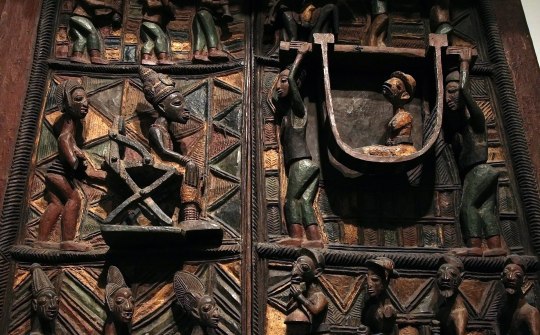
View On WordPress
#African Art#African History#The Master of Ikerre#West African#West African history#Yoruba architecture#Yoruba door#Yoruba History#Yoruba people
2 notes
·
View notes
Text

//For some reason, I woke up with 'Santeria' by Sublime stuck in my head, and it reminded me that Voudou is not the only African diasporic religion of the Caribbean. So I decided to check it out if it's appropriate for Abena. Turns out-
…No. Its origins are in Cuba. And it would be highly anachronistic because it developed during the late 19th century (Abena is 17th century).
So with this in mind, I decided to check out Haitian Voudou, because while in the past I have been researching what it IS, I never bothered its history--or its ethnic and origins. And behold--

Hm. Abena is specifically Akan, and she is of the Spanish part of Haitian history, before the French took over. And Akan are known as among the ethnic groups enslaved into Haiti and the Caribbean, those areas have their own takes of the Anansi mythos.
I decided to double-check native African vodun as a cross reference, and…. well then.

So while Vodun is present in Ghana, it would not be ethnically appropriate for Abena. She would have been raised in the indigenous forms of Akom, the religion of the Akan people. And from my observations of Akan mythology and folklore growing up, it does not at ALL resemble Voudou, Vooodoo, or Vodun at ALL.
So I made the right call in avoiding associating "generic African witch" with voodoo, etc. Cappn suggests Abena obtained the nickname 'Madame Voodoo' prior to joining the Seven out of ignorance from Europeans who think voodoo = black people magic. And Abena always bullshitted her ways through confidence tricks anyway. I can imagine (ex)slaves of Aja, Ewe, Fon, etc., descent would be highly critical of Abena carrying around that moniker while she's neither of these identities at all.
And even with all this, Abena would end up becoming an agnostic. I highly doubted she faced any religious trauma beyond "why isn't Nyame answering my prayers?" in the same ways the others in the Crew faced theirs. Her agnosticism likely comes from just simply observing syncretism taking place all over everyone she knew, forced or not, so it's just a matter of treating the mixing of faiths as not any different from taking on a neutral stance on mixing philosophies.
Modern-day Akom has a lot of influences from Christianity and Islam (from North African trade), so picking out which is indigenously Akan and which is Christian/Islam is somewhat of a challenge. With that said, a lot of Akom is polytheistic animist in nature, just like pre-Spanish Filipino faiths in the anito and diwata. So it's just a matter of identifying which traditions are Christian, Islam, and indigenous Akan.
I'd love to play around with Akom elements to Abena some more like I do with Christian/Jewish/Muslim/Taoist themes with the rest of the Crew. I grew up on so many stories of Anansi and Nyame growing up, I'm somewhat more personally familiar with Akan folklore than, let's say, Norse mythology. And I already use Anansi influences on Abena due to her being a cunning trickster. It's just a matter of how to make it more apparent gracefully.
#slavery tw#religion tw#realtalk I LOATHE everytime Africa the continent is treated as a single country#you have the Zulu and Xhosa and Yoruba and Swahili and Ngbo and Hutu etc#the diversity of Africa as a continent is frequently ignored and it pisses me off#I VERY would not want to be put in the same group (as a Tagalog) with the Ilongo or Ilocano or whatnot#so I'm happy to go back to reading about the Akan and other elements of African history in the Caribbean#I want more movements where people make more efforts in distinguishing the different ethnicities of African people in general#[About Abena]
1 note
·
View note
Text
Focusing on the Oyo Empire first in West Africa for specific reasons:
Out of the various African states in West Africa and the Sahel to receive more specific focuses, the Oyo Empire comes first for very specific reasons. Not least that it was the established power in the land when Usman Al Fodio built the Fulani Jihad to undermine it out of anger and envy that a proudly and defiantly infidel state had greater power than the Muslim majority around it. Second, that in contrast to the events of The Woman King in actual history it was Dahomey Amazons raiding their fellow pagans in Oyo for the slave trade rather than the other way around.
And of course in the other aspect because Yoruba people, of whom this was their major state, are a key component in the various religions of Voudoun, Santeria, and Candomble and their historical-cultural traditions are key to the African diaspora. Yoruba, Igbo, and Ashanti were among the groups most ravaged by the trade, and for this history 'rewarded' them by making the victims the villains with a straight face.
#lightdancer comments on history#black history month#military history#yoruba people#empire of oyo#dahomey amazons#the woman king#the woman king is a good film but as historical as that dinosaur movie with the four-legged Tyrannosaurus
0 notes
Text
Fantasy Guide to Building A Culture
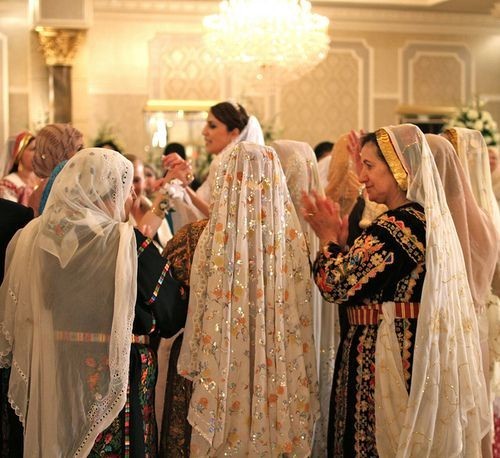
Culture is defined by a collection of morals, ethics, traditions, customs and behaviours shared by a group of people.
Hierarchy and Social Structures
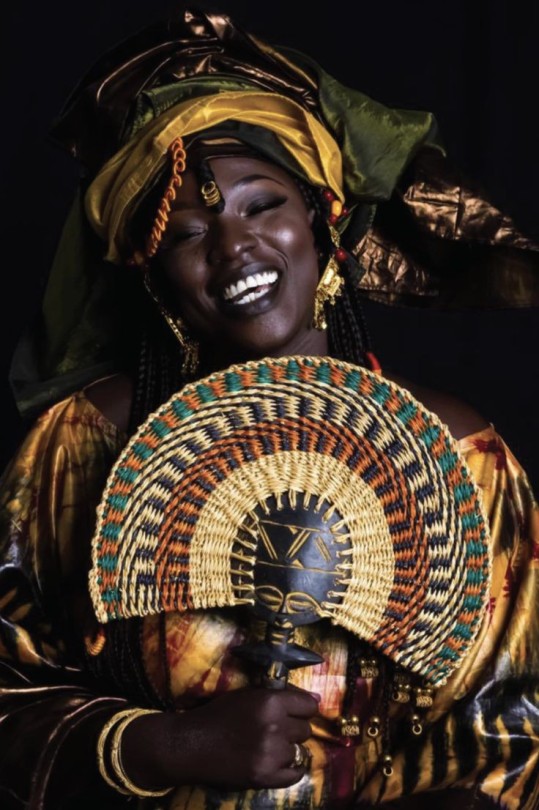
Within every culture, there is a hierarchy. Hierarchies are an important part of any culture, usually do ingrained that one within the culture wouldn't even question it. Hierarchy can be established either by age, gender or wealth and could even determine roles within their society. Sometimes hierarchy can may be oppressive and rigid whilst other times, ranks can intermingle without trouble. You should consider how these different ranks interact with one another and whether there are any special gestures or acts of deference one must pay to those higher than them. For example, the Khasi people of Meghalaya (Northern India), are strictly matrillineal. Women run the households, inheritance runs through the female line, and the men of the culture typically defer to their mothers and wives. Here are a few questions to consider:
How is a leader determined within the culture as a whole and the family unit?
Is the culture matriarchal? Patriarchal? Or does gender even matter?
How would one recognise the different ranks?
How would one act around somebody higher ranking? How would somebody he expected to act around somebody lower ranking?
Can one move socially? If not, why? If so, how?
Traditions and Customs
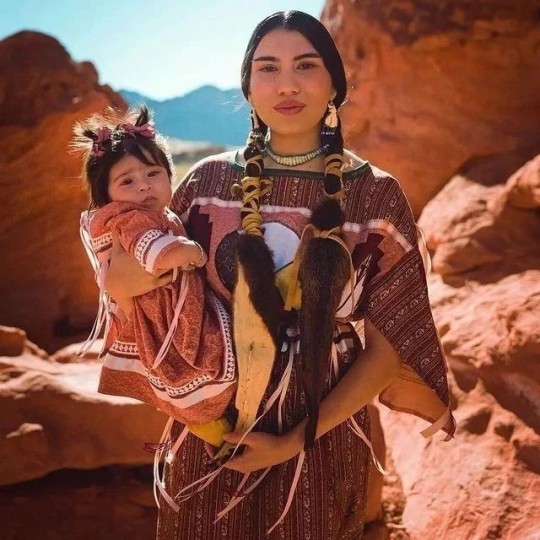
Traditions are a staple in any culture. These can be gestures or living life a certain way or to the way a certain person should look. Traditions are a personal detail to culture, they are what make it important. Tradition can dictate how one should keep their home, run their family, take care of their appearance, act in public and even determine relationship. Tradition can also be a double edged sword. Traditions can also be restrictive and allow a culture to push away a former member if they do not adhere to them, eg Traditional expectations of chastity led to thousands of Irish women being imprisoned at the Magdelene Laundries. Customs could be anything from how one treats another, to how they greet someone.
How important is tradition?
What are some rituals your culture undertakes?
What are some traditional values in your world? Does it effect daily life?
Are there any traditions that determine one's status?
Values and Opinions
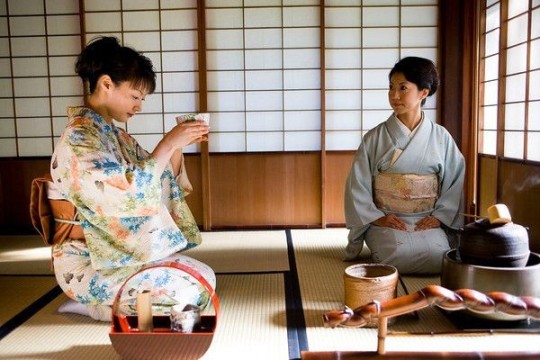
Values and Opinions are the bread and butter of any culture. This is the way your culture sees the world and how they approach different life hurdles. These may differ with other cultures and be considered odd to outsiders, what one culture may value another may not and what opinion another holds, one may not. There will be historical and traditional reasons to why these values and opinions are held. Cultures usually have a paragon to which they hold their members to, a list of characteristics that they expect one to if not adhere to then aspire to. The Yoruba people value honesty, hard work, courage and integrity. Here are some questions to consider?
How important are these ethics and core values? Could somebody be ostracised for not living up to them?
What are some morals that clash with other cultures?
What does your culture precieved to be right? Or wrong?
What are some opinions that are considered to be taboo in your culture? Why?
Dress Code
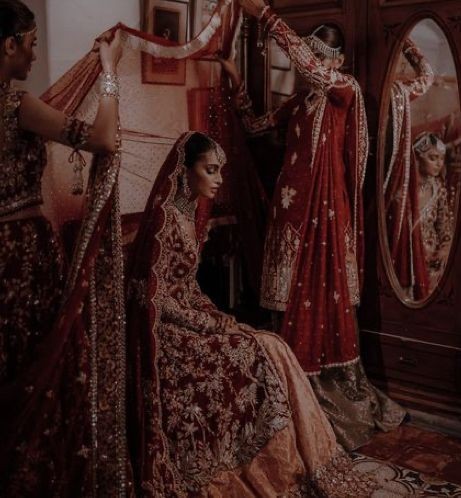
For many cultures, the way somebody dresses can be important. History and ethics can effect how one is meant to be dressed such as an expectation of chastity, can impose strict modesty. While other cultures, put more importance on details, the different sorts of clothes worn and when or what colour one might wear. The Palestinian people (من النهر إلى البحر ، قد يكونون أحرارا) denoted different family ties, marriage status and wealth by the embroidery and detailing on their thoub.
Are there traditional clothes for your world? Are they something somebody wears on a daily basis or just on occasion?
Are there any rules around what people can wear?
What would be considered formal dress? Casual dress?
What would happen if somebody wore the wrong clothes to an event?
Language

Language can also be ingrained as part of a Culture. It can be a specific way one speaks or a an entirely different language. For example, in the Southern States of America, one can engage in a sort of double talk, saying something that sounds sweet whilst delivering something pointed. Bless their heart. I have a post on creating your own language here.
Arts, Music and Craft

Many cultures are known for different styles of dance, their artwork and crafts. Art is a great part of culture, a way for people to express themselves and their culture in art form. Dance can be an integral part of culture, such as céilí dance in Ireland or the Polka in the Czech Republic. Handicrafts could also be important in culture, such as knitting in Scottish culture and Hebron glass in Palestine. Music is also close to culture, from traditional kinds of singing such as the White Voice in Ukraine and the playing of certain instruments such as the mvet.
Food and Diet
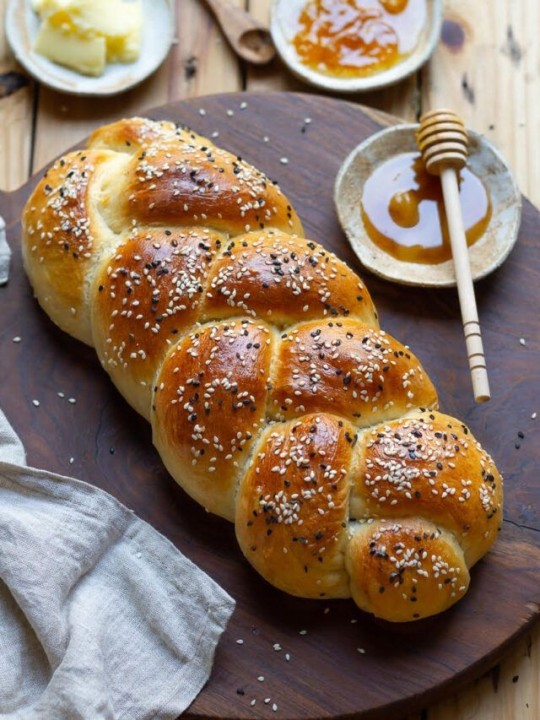
The way a culture prepares or intakes or treats certain foods are important to a culture. In some cultures, there is a diet yo adhere to, certain foods are completely banned. With Jewish culture, pork is prohibited along with fish such as sturgeon, along with shellfish and certain fowl. Meat must also be prepared in a certain way and animal byproducts such as dairy, must never be created or even eaten around this meat. This is known as kosher. The way one consumes food is also important to culture. In some cultures, only certain people may eat together. Some cultures place important on how food is eaten. In Nigerian culture, the oldest guests are served first usually the men before the women. In Japanese culture, one must say 'itadakimasu' (I recieve) before eating. Culture may also include fasting, periods of time one doesn't intake food for a specific reason.
What are some traditional dishes in your world?
What would be a basic diet for the common man?
What's considered a delicacy?
Is there a societal difference in diet? What are the factors that effect diet between classes?
Is there any influence from other cuisines? If not, why not? If so, to what extent?
What would a typical breakfast contain?
What meals are served during the day?
What's considered a comfort food or drink?
Are there any restrictions on who can eat what or when?
Are there any banned foods?
What stance does your world take on alcohol? Is it legal? Can anybody consume it?
Are there any dining customs? Are traditions?
Is there a difference in formal meals or casual meals? If so, what's involved?
Are there any gestures or actions unacceptable at the dinner table?
How are guests treated at meals? If they are given deference, how so?
#Fantasy Guide to Building A Culture#As promised#If I fail my German exam I'm blaming ye#Culture#Building a culture#Fantasy Guide#WorldBuilding#WorldBuilding guide#WorldBuilding help#Writing help#writing#writeblr#writing resources#writing reference#writing advice#ask answered questions#writers#writing advice writing resources#spilled ink#ask answered
10K notes
·
View notes
Text
Some historical context for Olrox

Okay, let me prephase this with one important message: Castlevania Nocturne made me really happy by making the plot all about colonialism, as colonialism and its fallout and how it influences us to this day is a topic that I am very passionate about. We do not talk enough about it. The US does not talk enough about it because it could make white people feel uncomfortable. And here in Germany we do not talk about it, because we act as if this had nothing to do with us at all.
But the show talks about it and I love it.
And I honestly also gotta say that I love that the BI_PoC character have a concrete cultural heritage. Olrox is Aztec, Annette is Yoruba, and Drolta is Egyptian. Other shows: Please take notes!
But let's talk Olrox, because he is so fucking interesting and amazing!
We know about him that he is Aztec and also that he is 250 years old. Or roughly that old by the time he kills Julia. Which would put either his birth or his turning somewhere around 1530.
Now, the fall of the Aztec Empire has a very exact date: August 13th, 1521. But you should keep in mind that this does not mean that on that day the Aztec's are extinct. To this day there is still 1,5 million people speaking Nahuatl, the language of the Aztecs, and preserving some of the Aztec cultural traditions. It was just that on that day the empire construct fell to Cortez and the Spaniad conquistadors and a lot of Aztecs went into exile to flee the genocide that Cortez was bringing upon them.
The question of course is: Was Olrox still human at this time or was he already a vampire? From his dialogue it is clear that he was at least alive and grown enough to remember the fall of the empire and the distruction Cortez and his men brought upon them. But you can bet it was very traumatic.
I also am assuming he was turned by a white man. Because so far my assumption is that vampirism is an old world thing that got brought to the new world through colonialism. (Mostly because in Dracula's court we do not see any new world vampires.)

Now, the other interesting thing is what he says about his dead lover. The one Julia killed. So, first the "town in Massachusetts" he speaks about is clearly Stockbridge. Which was the town in which many Mohicans have settled during the colonial times, as well as other people from the Iroquois Nations. Now, it should be noted that the Mohicans were not part of the Iroquois alliance and in fact went to war with the Iroquois, but by the time colonialism really geared up there was some cooperation between the Mohicans and Iroquois.
Due to this they were in an alliance with the Oneida (who were part of the Iroquois) by the time of the Revolutionary war. Now, the Revolutionary War created a lot of conflict between the Iroquois nations, because they did not agree which side they should fight on. Of course both sides promised that they could keep their land, but the Mohawk, Onondaga, Cayuga, and Seneca did not trust the colonists and hence sided with the British, while the Oneida and Tuscarora (and through them also the Mohicans) sided with the Colonists.
And the dead lover clearly was among those siding with the colonists. Now, a quick refresher for the non-Americans (and the Americans who slept to history class, which is understandable). The Revolutionary War lasted from April 19, 1775 to September 3, 1783 (which, yes, also means that Julia and Richter probably were in the US during the war the entire time and the "evil" Julia was fighting probably was linked to it). And of course we all know how it ended for the Indigenous people: The colonists won, countless Indigenous folks died on both sides, only to get booted of their land soon after. The Oneida und Mohicans were made to move westwards not soon after the war ended. So, yes, Olrox would have seen that happen.

Now, an interesting thing in his dialogue was when Erzebet said: "We will create a new world." To which he replies: "I have heard that one before." And she says: "This time we are going to make it to last."
And the big question is to what this is refering. Is it refering to the colonialization or is it refering to the revolutionary war? Or something entirely different. In both cases it would be possible. And yes, the American Revolution definitely were claiming to create a new world. But was it that what he refered to or something else?
Well, never the less: Interesting character. Really good writing.
#castlevania#castlevania nocturne#castlevania netflix#castlevania nocturne spoilers#castlevania olrox#american history#history#colonialism#colonial history#aztec
5K notes
·
View notes
Note
do you think that sumeru is just as bad as natlan? i was so upset when people stopped talking about it
Sumeru is bad. It's pretty, I'll give it that, it was my favourite nation when I used to play the game (I mained Faruzan), but it has its sum of terrible things
I don't know much about the source material, aka the Middle East, North Africa and South Asia. My post was about Natlan because if there's something I know about is my homeland.
I regret overlooking the signs hyv gave us of its racism early on, in 3.0. Seeing the Natlan trailers and leaks really opened my eyes on how I was being the kind of person that doesn't speak up on bad things when they happened to others. I don't wish that upon anyone. I hope we can have our eyes open for other games showing these signs in the future.
I won't "rank" that kind of thing because 1. I know next to nothing about Sumeru's source material (except for my share of self study in it's pattern art history) and 2. Natlan is not out as of now. I think it's bad, but I don't actually know much beyond the whitewashing.
I hope Hoyoverse didn't use their Gods' names similarly with how they dis to us, yoruba and candomblé. I can't remember. All my love to my brothers and sisters around the world, in those places!
Thank you for the ask!
#boycott hoyoverse#boycott Hoyoverse#boycott hyv#genshin impact#diluc x reader#alhaitham#kaveh#kavetham#haikaveh#kamisato ayato#raiden ei#arlecchino#aether#lumine#xiaoaether#xiaolumi#hsr#furina#neuvillette#wriothesley#navia#sigewinne
171 notes
·
View notes
Text

#BlackHistory365 Art Round-Up ⬇️
Elsa Soares via @rodrigoincolors
"This is Elsa Soares. She's one of the biggest names in Brazilian music and considered a matriarch of Brazilian black artistry. BBC named her the voice of the millenium and she was one of the most important and loudest voice against racism, LGBTQIA+ and women rights, among other social causes. She's died yesterday at age 91. This is a very simple, but sincere tribute to her. May you rest in power!
Please, listen to her music and search more about this great woman."

2. Portrait of Sarah Forbes Bonetta by Hannah Uzor via @fyblackwomenart
Portrait of Sarah Forbes Bonetta by Hannah Uzor
Sarah Forbes Bonetta was an Egbado princess of the Yoruba people in West Africa who was orphaned during a war with the nearby Kingdom of Dahomey and later became the slave of King Ghezo of Dahomey. In a remarkable twist of events, she was liberated from slavery by Captain Frederick E. Forbes of the British Royal Navy and became a goddaughter to Queen Victoria. She was married to Captain James Pinson Labulo Davies, a wealthy Lagos philanthropist.
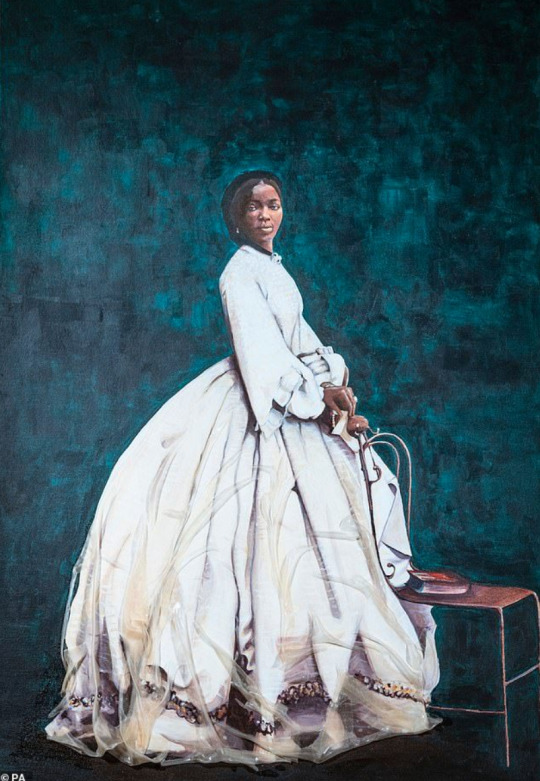
3. Marian Anderson by @novva
I’ve always wanted to do a series on black classical singers for BHM, so here’s a sketch I squeezed in this week—a tribute to the great Marian Anderson!
Marian Anderson (February 27, 1897 – April 8, 1993) was an African-American opera singer and contralto. In 1939, after the Daughters of the American Revolution refused to allow Anderson to sing to an integrated audience in Washington, D.C, then First Lady Eleanor Roosevelt and her husband President Franklin D. Roosevelt arranged for Anderson to perform an open-air concert on the Lincoln Memorial steps on Easter Sunday, April 9, 1939. She was able to deliver a critically acclaimed performance before an integrated crowd of more than 75,000 people, and a radio audience in the millions.
Read more about her accomplishments here, and donate to the National Marian Anderson Museum here.
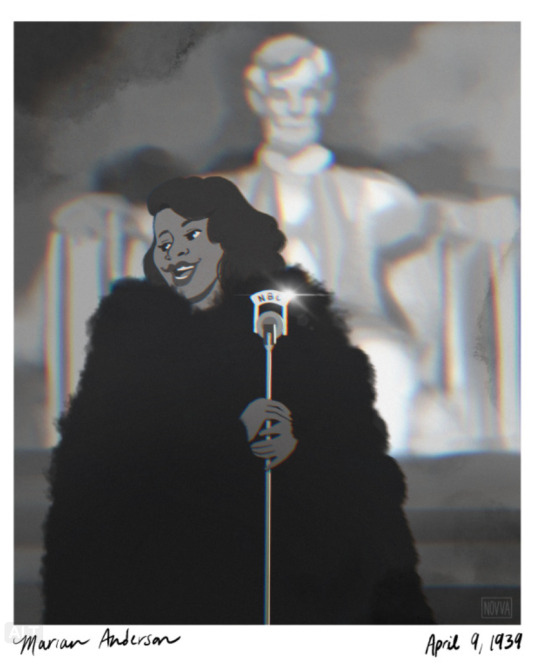
Remember: tag your history & trailblazers art with #BlackExcellence365 for a chance to be featured!
And keep your eyes out for next month's theme... 👀
#blackexcellence365#blackjoyisblackexcellence#blackjoy#blackexcellence#black excellence#black excellence 365#black history month#all black everything#celebrating black history#black history matters#black history#black culture#black lives matter#today in black excellence#black tumblr#blktumblr#black artists on tumblr
2K notes
·
View notes
Note
What makes a practice a closed practice? I have seen people say “this is a closed practice” or “doing this is a closed practice” but I never understood it once, what does a practice being closed mean and how does a practice become closed?
a closed practice refers to a spiritual or cultural tradition restricted to a specific group of people, often tied to ancestry, heritage, or initiation. These practices are protected to preserve their sacredness and cultural identity, and participation is typically limited to those within the originating group or who have received formal permission or training.
What makes a practice labeled as a closed practice?
1) Cultural and Historical Significance: The practice is integral to the identity of a specific cultural group, often stemming from a history of colonization or marginalization.
2) Sacred Knowledge: These practices include teachings, rituals, or symbols considered sacred and guarded against misuse or misrepresentation.
3) Initiation or Ancestral Connection: Some practices require a direct cultural connection, ancestral ties, or formal initiation from someone within the tradition. (This can be founded in a lot of African diaspora religions and African traditional religions, as well with many rites of Hinduism & Buddhism)
4) Protection from Cultural Appropriation: Many closed practices have been historically exploited or commodified by outsiders, leading to their communities enforcing strict boundaries.
Examples of Closed Practices:
1) Santería (Regla de Ocha): A syncretic Afro-Caribbean religion originating in Cuba. Participation requires formal initiation, and the practice is deeply tied to the descendants of enslaved Africans and their connection to the Orishas, many people are also born into this practice and taught within it, so it’s basically initiation
2) Palo Monte (Palo Mayombe): An Afro-Cuban spiritual tradition with Bantu roots. It involves working with spirits(mpungus), sacred cauldrons (ngangas), and ancestral veneration(nfumbes also called nfumbis). Only those initiated into the practice can properly perform its rituals.
3) Curanderismo Rituals (Specific Forms): While some elements of Curanderismo (a Latin American healing tradition) are open, certain rituals—such as those tied to family lineages or Indigenous practices—are closed and not meant to be shared or practiced outside of the culture.
4) Mesoamerican Indigenous practices: A sacred sweat lodge ritual originating with Indigenous peoples like the Nahua and Maya. It’s intended for spiritual and physical cleansing and requires knowledge of traditional protocols.
5) Hoodoo: A syncretic African American spiritual tradition with roots in African, Indigenous, and European practices. Its rituals, especially those involving ancestral veneration and spiritual guidance, are deeply personal and should be approached with respect and understanding of their origins.
6) Brujería(no not in as the Spanish word but the folk magic of Latin America) A Latin American spiritual tradition that incorporates witchcraft, healing, and ancestral worship. Participation in Brujería often requires Latin American heritage, particularly in practices tied to familial and cultural heritage since most of it is passed down
7) Candomblé: A syncretic Afro-Brazilian religion with roots in Yoruba, Fon, and Bantu traditions. Like Santería, it requires formal initiation to participate in rituals and interact with the Orishas.
8) Amazigh Practices: Spiritual traditions of the Amazigh people in North Africa, particularly in regions of Morocco, Algeria, and Tunisia. These practices involve sacred rituals, herbal healing, and ancestral worship, often passed down through generations and typically reserved for those with a direct cultural connection.
Why Are These Practices Closed?(not limited)
1) They serve as a means of preserving cultural identity and resilience, especially in the face of colonization and erasure.
2) Misuse or commodification by outsiders often distorts their meaning, disrespects their sacredness, and exploits the communities they come from.
Respecting closed practices involves honoring the boundaries set by the communities that hold them sacred and engaging only when invited or trained by members of the tradition.
#bruja#taino#arawak#brujasoftumblr#spirituality#tainoarawak#brujeria#cemi#reconnecting taino#santeria#witchesoftumblr#witchblr#brujas of tumblr#brujas de tumblr#brujablr#bruja tumblr#espiritismo#espiritista#lukumi#Lucumi#witchcraft#witches of tumblr#witchy#witch community#witch
87 notes
·
View notes
Text
Deities, Figures, And Spirits of Rebellion, Revolutions, and Resistance.
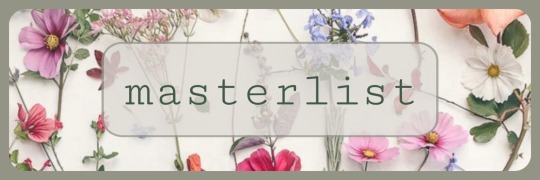
While Tensions are High and emotions flood the body and mind, I like to think back to time and how history has birthed incredible and magnificent people throughout its unforgiving march forwards. And I think of those figures and people or those gods and stories, and I remind myself of their presence and how they shook the time and the eras that they occupied. I’m in love with them. And I admire them. Whether they are trickster Spirits that stand against Authority and embrace strength against adversity or fighting against authority and resisting the status quo, I often admire and think of them. I think of them fondly and I nod to them through Space and Time, and by thinking of them, I carry them in my heart. And I am motivated by their Light and the Inspiration that they have brought across the ages. I know that they are *there*. Eons apart from me or in spaces and spirit that I cannot grasp anywhere but within my very spirit. They are there. And I am holding them in my spirit and heart and they are holding me. And I move with their spirit and their awareness. And I nod to them. And they, to me. I wanted to provide a large list of Figures, Saints, Gods or other individuals and Beings commonly venerated, worked with or worshiped as icons of resistance and overcoming trying times. History is steeped in trials and circumstances where the oppressed and hunted have overcome great adversity or stood against the tides that seek to bring harm unto them. Here, I will list figures that you can draw upon or look to in your hours of need. If you seek a Revolutionary, you may find one Here. (feel welcome to add some as this crosses your path!)
Some Saints:
St. Michael the Archangel – Known as the chief warrior angel, St. Michael is often invoked for protection and strength in battles and against evil.
St. Joan of Arc – The French saint who led her country in battles against English forces during the Hundred Years' War. She’s celebrated for her courage and conviction against overwhelming odds.
St. Jude Thaddeus – Known as the patron saint of lost causes, people turn to him in desperate situations for help in overcoming challenges that seem impossible.
St. Sebastian – Often depicted as a martyr who survived multiple executions, he became a symbol of strength, resilience, and steadfastness in the face of persecution.
St. George – Known for slaying a dragon, St. George is a symbol of overcoming evil and oppression. Often associated with courage in adversity.

Deities:
Sekhmet (Egyptian Mythology) – The lion-headed goddess of war and healing, Sekhmet is revered for her fierce power and for defending the oppressed.
Morrigan (Celtic Mythology) – The Celtic goddess of battle and sovereignty, Morrigan embodies both the power to protect and to incite change. She is often seen as a guardian of the land, appearing before battles to inspire or instill fear in the enemy.
Kali (Hinduism) – Goddess of destruction and rebirth, Kali represents the destruction of evil and is often invoked for overcoming difficult circumstances and for protection against oppressive forces.
Oya (Yoruba/Orisha Tradition) – Goddess of winds, storms, and transformation, Oya is a fierce warrior who stands up against oppression and is often turned to for protection and resilience. Ogun (Yoruba/Orisha Tradition) – The god of iron, war, and labor, Ogun is a force for justice and is often invoked in situations requiring resilience and the strength to overcome oppression. He’s seen as a revolutionary spirit for those seeking to break free from their constraints. Eshu (Yoruba/Orisha Tradition) – Known as the divine messenger and trickster, Eshu brings both disruption and opportunity. As a god of crossroads, he’s associated with challenging authority and initiating change, reminding followers that revolution often begins with unexpected choices. Yemaya (Yoruba/Orisha Tradition) – The mother of all life and goddess of the sea, Yemaya is often associated with resilience, protection, and the healing of generational trauma. As a nurturing and revolutionary spirit, she is frequently invoked for personal and collective strength. Queen Nanny of the Maroons (Jamaican Folklore) – A legendary figure and spirit in Afro-Caribbean culture, Queen Nanny was a leader of the Maroons who resisted British colonial forces. She’s honored as a warrior and symbol of independence and strength.
Huitzilopochtli (Aztec Mythology) – The god of war and the sun, Huitzilopochtli led the Aztecs through harsh conditions to establish their empire. He symbolizes endurance, perseverance, and overcoming obstacles.
Inanna/Ishtar (Mesopotamian Mythology) – Goddess of love, war, and justice, she descends into the underworld and returns, representing survival through dark times and resistance against forces of oppression.
Manjushri (मञ्जुश्री) (Buddhist Bodhisattva) - Manjushri is venerated across the Buddhist world as an embodiment of wisdom, with devotees seeking his guidance to develop the courage and insight necessary to face personal and societal challenges. Manjushri holds a flaming sword that symbolizes the cutting of ignorance and illusion, a powerful symbol of spiritual revolution and awakening. He represents the transformative power of wisdom and the courage to overcome ignorance, delusion, and societal conventions, which align with themes of inner revolution.
Susanoo (建速須佐之男命) (Japanese Shinto) – The god of storms and the sea, Susanoo is known for his rebellious nature against the heavenly order, and he’s often venerated for his unyielding spirit. He’s remembered for protecting people by slaying a great serpent, representing courage and the ability to challenge authority.
Amaterasu (天照大御神 / 天照大神) (Japanese Shinto) – Though primarily known as the goddess of the sun and order, Amaterasu withdrew from the world when her brother acted destructively, only returning when lured back by others. Her story reflects the themes of resilience and the power to restore light and hope.
Guan Yu (关羽) (Chinese) – A legendary general deified as a god of war and protection, Guan Yu is known for his loyalty, bravery, and sense of justice. He’s widely worshipped as a guardian figure who defends the oppressed and inspires people to uphold righteousness and loyalty.
Nezha (哪吒) (Chinese) – A child warrior deity known for his rebellious spirit, Nezha is celebrated for resisting oppression, particularly against tyrannical figures in the heavens. He represents youth, resilience, and defiance against unjust authority, often empowering those who feel marginalized or oppressed.
Xiwangmu (西王母) (Chinese) – Also known as the Queen Mother of the West, Xiwangmu is a powerful goddess associated with healing, protection, and transformation. While not a revolutionary in the typical sense, she embodies resilience, independence, and the power of women in a traditionally male-dominated pantheon.
Zhong Kui (钟馗) (Chinese) – Known as the demon slayer, Zhong Kui is a spirit of justice who fights against evil spirits and brings protection to those who feel haunted by oppression. He is venerated as a deity who can help people overcome fears and defeat obstacles that seem insurmountable.
The Eight Immortals (八仙) (Chinese) – A group of legendary Taoist figures, each with unique powers, who often challenged the social order. Figures like Lü Dongbin and Zhang Guolao used their abilities to help people and protect them from corrupt rulers and evil forces, embodying the spirit of defiance against oppressive systems.
Sun Wukong (孙悟空) (Chinese) - The central figure in the 16th century novel “Journey to the West (西游记) but also a figure in Mythology, Sun Wukong stands against authority and inspires both resistance and strength as well as dynamic growth.

Demons:
Lord Lucifer - The Adversary and Illuminator. Lucifer is a longstanding figure of bearing the light in the darkness and fighting against overwhelming oppression and control of powers that deem themselves tyrants. Lucifer fights and battles against forces that subjugate the oppressed.
Lord Asmodeus – Known in demonology as a figure representing strength, ambition, and power, Asmodeus is sometimes invoked for resilience, drive, and confidence to overcome personal and external challenges.
King Belial – Often associated with independence and personal power, Belial is sometimes venerated for helping people stand strong in their own beliefs and against unjust authorities.
Mother Lilith – A figure of independence and resistance, Lilith is revered in some traditions as a symbol of feminine power and autonomy, especially in standing against oppression and patriarchal structures.
Lord Buer – Demon of healing and knowledge, called upon for mental strength and overcoming illness or hardship through wisdom and resilience. Promotes mental health and healing as well as encourages growth through overcoming your mental blockages.
Lord Leviathan - The Lord of Shadow Working. Lord Leviathan helps you navigate the deep and dark waters of your mind where you may feel overwhelmed and drowning. Lord Leviathan can bring you clear waters and help support you when the tides feel like they may pull you down.

Secular Saints & Venerated Figures, Other Folkloric figures and Revolutionaries:
Harriet Tubman – Though not formally canonized, Harriet Tubman is often seen as a symbol of liberation and resilience, escaping slavery and leading others to freedom.
Malcolm X – An icon of strength, self-determination, and resistance, especially in the context of racial oppression. His life inspires resilience and the fight for justice.
Hypatia of Alexandria – Known for her wisdom and intellectual resilience, Hypatia became a symbol of strength and survival in a time when powerful figures often sought to silence knowledge.
Nelson Mandela – Revered globally for his resilience and role in overcoming apartheid, Mandela is a secular saint for many, representing strength and the spirit of resistance.
Frida Kahlo – Known for her resilience through physical and emotional pain, Kahlo’s life and work are often venerated as symbols of strength, personal power, and survival against all odds. Cuauhtémoc (Aztec/Mexica Tradition) – The last Aztec emperor who resisted the Spanish conquistadors. He is remembered as a hero who fought courageously to protect his people, embodying resilience and the spirit of resistance in Mexican culture.
Emiliano Zapata (Mexican Folk Hero) – Though not a deity, Zapata’s revolutionary spirit against oppressive forces has made him almost a legendary figure in Mexican folklore. He’s revered as a folk saint and a symbol of the fight for social justice and indigenous rights.
Hua Mulan (Chinese Folklore) – Celebrated for her bravery and willingness to challenge gender norms, Mulan fought in her father’s place in the army. Her story is a symbol of courage, resilience, and overcoming social constraints.
Kumari (Nepalese Tradition) – Known as the living goddess of Nepal, the Kumari is believed to embody divine power and protection for the people. She serves as a symbol of resilience and cultural endurance in the face of modernization and outside influence.
Zumbi dos Palmares (Afro-Brazilian Tradition) – A leader of a community of escaped slaves (Quilombo dos Palmares) in Brazil, Zumbi is honored as a hero and symbol of freedom, resistance, and African heritage in Brazil.
Yue Fei (岳飞) – A historical general from the Song Dynasty who became a symbol of loyalty, patriotism, and resistance against foreign invaders. Despite betrayal and wrongful execution, Yue Fei is venerated as a hero who embodies loyalty to one’s people and the fight against oppression.
Li Shimin (Emperor Taizong of Tang, 唐太宗 李世民) – Known for his role in overthrowing the corrupt Sui Dynasty, Li Shimin played a crucial role in establishing the Tang Dynasty. He is respected as a revolutionary leader who brought stability and cultural prosperity to China.
Chen Sheng and Wu Guang (陈胜, 吴广) – These two commoners led one of the first rebellions against the Qin Dynasty’s harsh rule, sparking what would eventually become a larger revolt. They are remembered as symbols of the common people’s resistance against an oppressive regime.
The White Lotus Goddess (白莲教) – Associated with the White Lotus Society, this goddess represents spiritual resistance against corruption and oppression. The White Lotus sect played a significant role in several uprisings throughout Chinese history, including revolts against the Mongol Yuan Dynasty.
Chi You (蚩尤) – A figure from ancient mythology, Chi You was a tribal leader who fought against the Yellow Emperor. He is often depicted as a warlike figure who stood against established order. Though he was ultimately defeated, he became a symbol of rebellion and bravery in later cultural narratives.
Lü Zu (吕祖) – One of the Eight Immortals, Lü Dongbin (or Lü Zu) was known for challenging both heaven and earth, and he often sided with the poor and downtrodden. He encouraged people to resist worldly corruption, especially among the rich and powerful, inspiring resilience and self-cultivation.
Madame Zheng Yi Sao (郑一嫂) – Often called the Pirate Queen, she was one of the most powerful pirate leaders in history and led a massive fleet that defied the Chinese imperial government. Madame Zheng embodies resistance against oppressive authorities and is celebrated for her intelligence and revolutionary spirit.
#witchcraft#witchblr#devotional post#gods and deities#deity work#revolution#saints#secular saints#gods#goddesses#paganism#folklore#god worship#polytheism#deity worship#paganblr#current events#demons#demonic workings#demonolatry#chinese mythology#polytheist#shintoism#saint veneration
67 notes
·
View notes
Text
Yoruba Aringo Jagun (Ogun Ceremonial Axe), Nigeria, Late 19th To Early 20th century
An elegant iron staff axe created by a Yorùbá master blacksmith by reforging hoe blades worn out from many years of farming brings this point home. The focus object honors and instigates Òrìsà Òkó, the Yorùbá deity who assures wealth and prosperity through the fertility of the land. Detailing the considerable skill required to reforge hoe blades and thereby produce a magnificent staff axe, draws…

View On WordPress
#African Axe#African History#Ogun Ceremonial Axe#West African#West African history#Yoruba artifacts#Yoruba axe#Yoruba people
0 notes
Text
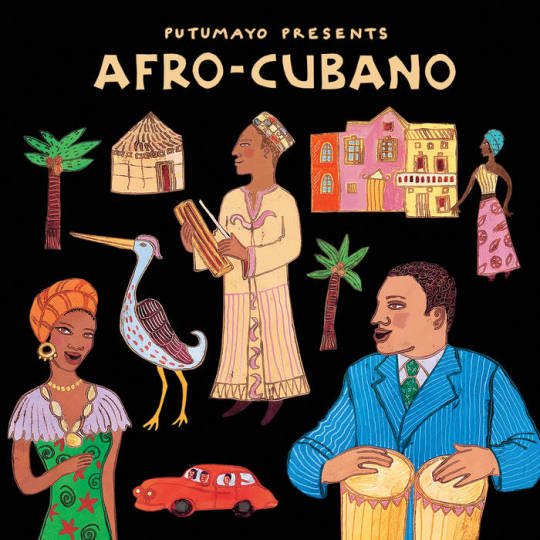
Music of African heritage in Cuba derives from the musical traditions of the many ethnic groups from different parts of West and Central Africa that were brought to Cuba as slaves between the 16th and 19th centuries. Members of some of these groups formed their own ethnic associations or cabildos, in which cultural traditions were conserved, including musical ones. Music of African heritage, along with considerable Iberian (Spanish) musical elements, forms the fulcrum of Cuban music.
Much of this music is associated with traditional African religion – Lucumi, Palo, and others – and preserves the languages formerly used in the African homelands. The music is passed on by oral tradition and is often performed in private gatherings difficult for outsiders to access. Lacking melodic instruments, the music instead features polyrhythmic percussion, voice (call-and-response), and dance. As with other musically renowned New World nations such as the United States, Brazil and Jamaica, Cuban music represents a profound African musical heritage.

Clearly, the origin of African groups in Cuba is due to the island's long history of slavery. Compared to the USA, slavery started in Cuba much earlier and continued for decades afterwards. Cuba was the last country in the Americas to abolish the importation of slaves, and the second last to free the slaves. In 1807 the British Parliament outlawed slavery, and from then on the British Navy acted to intercept Portuguese and Spanish slave ships. By 1860 the trade with Cuba was almost extinguished; the last slave ship to Cuba was in 1873. The abolition of slavery was announced by the Spanish Crown in 1880, and put into effect in 1886. Two years later, Brazil abolished slavery.
Although the exact number of slaves from each African culture will never be known, most came from one of these groups, which are listed in rough order of their cultural impact in Cuba:
The Congolese from the Congo Basin and SW Africa. Many ethnic groups were involved, all called Congos in Cuba. Their religion is called Palo. Probably the most numerous group, with a huge influence on Cuban music.
The Oyó or Yoruba from modern Nigeria, known in Cuba as Lucumí. Their religion is known as Regla de Ocha (roughly, 'the way of the spirits') and its syncretic version is known as Santería. Culturally of great significance.
The Kalabars from the Southeastern part of Nigeria and also in some part of Cameroon, whom were taken from the Bight of Biafra. These sub Igbo and Ijaw groups are known in Cuba as Carabali,and their religious organization as Abakuá. The street name for them in Cuba was Ñáñigos.
The Dahomey, from Benin. They were the Fon, known as Arará in Cuba. The Dahomeys were a powerful group who practised human sacrifice and slavery long before Europeans arrived, and allegedly even more so during the Atlantic slave trade.
Haiti immigrants to Cuba arrived at various times up to the present day. Leaving aside the French, who also came, the Africans from Haiti were a mixture of groups who usually spoke creolized French: and religion was known as vodú.
From part of modern Liberia and Côte d'Ivoire came the Gangá.
Senegambian people (Senegal, the Gambia), but including many brought from Sudan by the Arab slavers, were known by a catch-all word: Mandinga. The famous musical phrase Kikiribu Mandinga! refers to them.
Subsequent organization
The roots of most Afro-Cuban musical forms lie in the cabildos, self-organized social clubs for the African slaves, and separate cabildos for separate cultures. The cabildos were formed mainly from four groups: the Yoruba (the Lucumi in Cuba); the Congolese (Palo in Cuba); Dahomey (the Fon or Arará). Other cultures were undoubtedly present, more even than listed above, but in smaller numbers, and they did not leave such a distinctive presence.
Cabildos preserved African cultural traditions, even after the abolition of slavery in 1886. At the same time, African religions were transmitted from generation to generation throughout Cuba, Haiti, other islands and Brazil. These religions, which had a similar but not identical structure, were known as Lucumi or Regla de Ocha if they derived from the Yoruba, Palo from Central Africa, Vodú from Haiti, and so on. The term Santería was first introduced to account for the way African spirits were joined to Catholic saints, especially by people who were both baptized and initiated, and so were genuine members of both groups. Outsiders picked up the word and have tended to use it somewhat indiscriminately. It has become a kind of catch-all word, rather like salsa in music.
The ñáñigos in Cuba or Carabali in their secret Abakuá societies, were one of the most terrifying groups; even other blacks were afraid of them:
Girl, don't tell me about the ñáñigos! They were bad. The carabali was evil down to his guts. And the ñáñigos from back in the day when I was a chick, weren't like the ones today... they kept their secret, like in Africa.
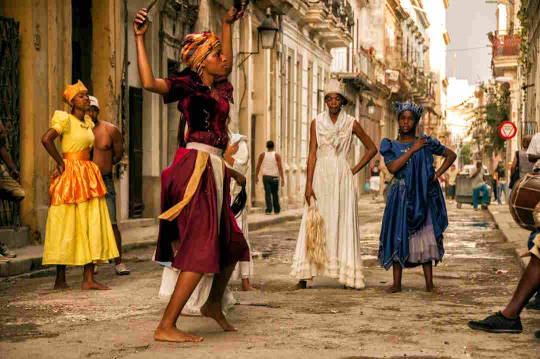
African sacred music in Cuba
All these African cultures had musical traditions, which survive erratically to the present day, not always in detail, but in the general style. The best preserved are the African polytheistic religions, where, in Cuba at least, the instruments, the language, the chants, the dances and their interpretations are quite well preserved. In few or no other American countries are the religious ceremonies conducted in the old language(s) of Africa, as they are at least in Lucumí ceremonies, though of course, back in Africa the language has moved on. What unifies all genuine forms of African music is the unity of polyrhythmic percussion, voice (call-and-response) and dance in well-defined social settings, and the absence of melodic instruments of an Arabic or European kind.
Not until after the Second World War do we find detailed printed descriptions or recordings of African sacred music in Cuba. Inside the cults, music, song, dance and ceremony were (and still are) learnt by heart by means of demonstration, including such ceremonial procedures conducted in an African language. The experiences were private to the initiated, until the work of the ethnologist Fernando Ortíz, who devoted a large part of his life to investigating the influence of African culture in Cuba. The first detailed transcription of percussion, song and chants are to be found in his great works.
There are now many recordings offering a selection of pieces in praise of, or prayers to, the orishas. Much of the ceremonial procedures are still hidden from the eyes of outsiders, though some descriptions in words exist.
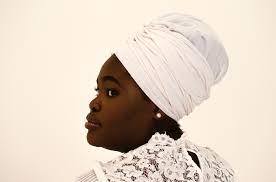
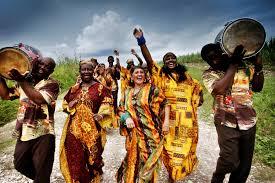
Yoruba and Congolese rituals
Main articles: Yoruba people, Lucumi religion, Kongo people, Palo (religion), and Batá
Religious traditions of African origin have survived in Cuba, and are the basis of ritual music, song and dance quite distinct from the secular music and dance. The religion of Yoruban origin is known as Lucumí or Regla de Ocha; the religion of Congolese origin is known as Palo, as in palos del monte.[11] There are also, in the Oriente region, forms of Haitian ritual together with its own instruments and music.
In Lucumi ceremonies, consecrated batá drums are played at ceremonies, and gourd ensembles called abwe. In the 1950s, a collection of Havana-area batá drummers called Santero helped bring Lucumí styles into mainstream Cuban music, while artists like Mezcla, with the lucumí singer Lázaro Ros, melded the style with other forms, including zouk.
The Congo cabildo uses yuka drums, as well as gallos (a form of song contest), makuta and mani dances. The latter is related to the Brazilian martial dance capoeira
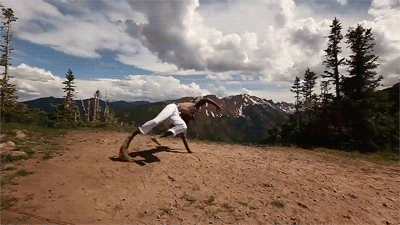
#african#afrakan#kemetic dreams#africans#brownskin#brown skin#afrakans#african culture#fitness#afrakan spirituality#afro cuban music#afro cuban#igbo#yoruba#congo#african music
195 notes
·
View notes
Text

𝗗𝗥𝗘𝗔𝗗𝗟𝗢𝗖𝗞𝗦
In the 1930s, dreadlocks were a fashionable hairstyle among Rastafarians. The Rastafarian movement, which originated in Jamaica, is based on a blend of Christian and African spiritual ideas. Rastafarians believe that their hair represents the power and energy of their African ancestors, and they wear dreadlocks to reflect this belief. Dreadlocks are religious, but they have also become a sign of defiance and counterculture.
In the 1960s and 1970s, hippies and other groups who didn't like mainstream culture liked to wear dreadlocks. People have used locs for a variety of reasons throughout history. The Maasai warriors of Africa, for example, are renowned for wearing long, thin red dreadlocks dyed with red root extracts or red ochre. However, in Nigeria, infants who are born with naturally locked hair are referred to as "Dada" by the Yoruba.
The Rastafari movement thinks that dreadlocks are a sign of the Lion of Judah, which sometimes shows up on the Ethiopian flag. Rastafari supporters believe that Haile Selassie is a direct descendant of King Solomon and Queen Sheba through their son Menelik I and that the Nazarites recorded in the Bible inspired them to wear dreadlocks.
People of all races and ethnicities now sport dreadlocks as a fashionable hairstyle in many parts of the world. While they have religious and cultural value for some, many individuals just wear them as a fashion statement. Despite their rising popularity, dreadlocks have caused controversy and prejudice.
They have been outlawed in several businesses and schools, and some people have encountered prejudice due to their haircut. In the end, the history of dreadlocks is long and varied. They have deep roots in ancient cultures and are still important to culture today.
84 notes
·
View notes
Text
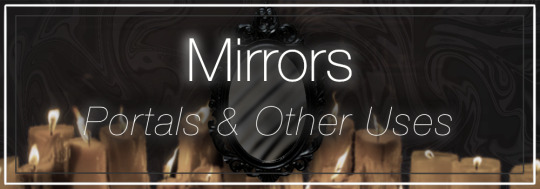
Title: Mirrors: Portals and Uses
Recommended Reading
Altars: Uses & Design Dimensions & PlanesDualities in Witchcraft Researching Witchcraft Spiritwork: First Steps Basics of Spellcasting Basics of Warding Basics of Banishing Energy Work Fundamentals Intermediate Energy Work The Subtle Body The Wellsource Correspondences: Research, Creation, & Use
Please note that some information on this post comes from personal experience as well as conversations with my elders and other practitioners.
Introduction
Mirrors harbor a unique and paradoxical role, often existing at the intersection of clarity and obfuscation. Throughout the annals of history, these reflective surfaces have been the subject of mystic fascination and contemplation. Shrouded in a mysterious aura, mirrors are an integral component of various mystical practices across diverse cultures.
A seminal instance is observed within the African Yoruba tradition, where mirrors are emblematic of Oshun, the deity of beauty, love, and prosperity. Here, these reflective surfaces serve as conduits to divine insight, manifesting the ethereal into the perceptible. Parallel to this, in the indigenous cultures of the Amazonian Shipibo-Conibo people, mirrors - often represented by reflective surfaces of water - are perceived as gateways to understanding the complex layers of the universe, thus embodying a significant spiritual tool. Moreover, in many East Asian practices, mirrors carry deep symbolic significance and are fundamental in rituals aiming to ward off malevolent forces. Among the Ainu people of Japan, for instance, mirrors function as amulets, protecting the holder from supernatural harm.

Mirrors as Portals
A ubiquitous yet perplexing facet is the concept of mirrors functioning as portals. These reflective surfaces, more than mere decorative elements or vanity tools, hold a quintessential place in mystic and magical practice, extending beyond their ordinary use to become intermediaries between the unknown and the practitioner. Diving into the understanding of mirrors, one might read about their role as gateways. The duality of mirrors, both reflective and transparent, presents a tantalizing paradox: what they display isn't a mere reflection, but an alternate universe or spiritual plane. This dichotomy positions mirrors as a connective threshold, an aperture between the observable and the unknown, the physical and the mystical. Despite their allure, mirrors necessitate careful handling within a magical context. It is a common misconception that mirrors only function as portals during explicit rituals. However, their latent potential as conduits should not be overlooked. Consequently, it's paramount that mirrors remain shrouded or safeguarded within consecrated spaces to prevent inadvertent connections to unwelcome energies. Approaching this aspect with a measure of respect and precaution is instrumental in maintaining the equilibrium of such spaces.
Historically, the mirror's role as a portal is discernible across a myriad of cultural contexts. In Greek mythology, Narcissus fell victim to his reflection in a pool of water, demonstrating an early symbol of mirrors as deceptive portals to the ego. In Chinese folklore, the mythical creature Nüwa repaired the heavens using a seven-colored stone, comparable to a mirror, again associating these reflective surfaces with cosmic transitions.
Mirrors often represent truth, knowledge, and self-awareness, owing to their reflective properties. However, their potential as portals imbues them with added dimensions of mystery, transformation, and transition. The mirror, in this context, becomes a metaphor for change and personal evolution, presenting a liminal space where the known meets the unknown, thereby offering new possibilities and perspectives.
Given the energetic properties inherent in mirrors, they should always be treated as portals. Their constituent materials - silica and silver - interact in such a way that a subtle, yet potent, energetic field is generated, a field potentially capable of bridging multiple planes. To ensure safety, mirrors should be handled with respect and caution. They should be appropriately covered or warded when not in use, especially within sanctified spaces. It is also recommended to cleanse mirrors regularly to reset their energetic state and prevent any residual energies from accumulating.
Energetic Interactions & Metaphysics
Energetic Interactions
Amid the energetic symphony of the universe, each object reverberates its unique energetic signature, contributing to the collective composition. Mirrors, with their paradoxical and captivating nature, have often been the center of esoteric investigation. This intrigue is rooted not only in their physical attributes but also in their nuanced energetic interactions.
To comprehend the energetic interplay of mirrors, one must first examine the properties of its constituent components. Primarily, mirrors are composed of glass, a substance formed from the supercooling of molten silica into a quasicrystalline structure. Coating the back of this silica-based surface is a thin layer of reflective metal, usually aluminum or silver.
Silica is very insulative, and negentropic, meaning that its natural energetic state eventually resets regardless of influence. It is also Attractive, meaning that it slowly pulls other energetic compounds to itself. Due to the quasicrystalline structure, glass is refractive and enthalpic, meaning that it becomes thermal under pressure- or releases energy. Silver is conductive and repulsive in nature. Due to how silver atoms prefer to arrange themselves (a face-centered cubic lattice) it also tends to be very metastable, meaning that its natural energetic state is not prone to change regardless of energetic interactions. Because the two are constantly next to each other, because of the silver backing, the negentropic nature of the silica causes an energetic cycle of attraction and repulsion, this oscillation combined with the conductive nature of silver and the entropic nature of glass generates a small energetic field. While this is normally negligible, it creates the perfect environment for the propagation of connections between spaces or planes that are out of phase with our own.
The unique composition of mirrors implicates a distinct effect on the ambient energy. Mirrors, with their inherent vibrational resonance, can both pull and push energy, thereby influencing the surrounding energetic atmosphere. The capacity of mirrors to manipulate energy finds practical applications in the sphere of spellwork and energy transmutation. Through their reflective properties, mirrors can serve as effective tools in spells that involve redirection or amplification of energy. They can be used to create energetic boundaries, return energetic influences, or focus and multiply ambient energy and energetic projections.
Common Metaphysics of Mirrors
The mirror, with its intrinsic capacity to reflect, serves as a potent symbol of the Jungian 'Shadow' - the hidden aspects of one's psyche that are often suppressed or ignored. Through the act of looking into a mirror, one is invited to confront and acknowledge these facets, facilitating a journey towards holistic self-awareness. The mirror, in this respect, catalyzes self-reflection and introspection, propelling an individual towards self-understanding and acceptance. Delving into the sphere of mirror magic uncovers its profound connection to personal transformation. The reflective nature of mirrors encapsulates the principle of change, embodying the potential for alteration and transformation. As such, mirror magic can be utilized as a tool for self-development and evolution, offering a means to focus energy towards constructive change. Beyond symbolism and transformation, the metaphysical properties of mirrors warrant exploration. Mirrors, by their construction and function, are potent energetic entities. The amalgamation of silica and metallic elements results in a unique vibrational resonance, enabling the mirror to absorb, store, and emit energy. This energetic characteristic, coupled with the mirror's reflective capacity, amplifies its metaphysical potency, making it an influential tool in various mystical practices. Moreover, the reflective nature of mirrors aligns them with the principle of 'as above, so below', a concept found in various esoteric traditions. This principle speaks to interconnectedness, suggesting that what occurs on one level of reality also happens on another. Mirrors could, therefore, serve as a solid physical replacement for any correspondence necessary.

Divination, Spells, & Ritual
In the enigmatic arena of divination, mirrors command a distinctive presence. Among various techniques, scrying - the act of gazing into a reflective surface to perceive spiritual messages - emerges as a common method of introspection and foreknowledge. This practice unfolds as a tripartite process, encompassing the scrying ritual, technique, and subsequent interpretation.
Scrying, an ancient form of divination, leverages the reflective properties of reflective surfaces, like mirrors, to delve into the psyche, unveil hidden knowledge, or prognosticate future events. This technique transcends conventional sensory perception, engaging instead with subconscious and/or spiritual entities. The mirror functions as a medium, harnessing and focusing the widened attention in order to project images or symbols onto the reflective surface. These visual constructs carry messages from the spiritual domain, providing insights that range from self-understanding to predictive revelations.
Techniques & Rituals for Scrying
Executing mirror scrying necessitates a meticulous approach. Often, the process commences with the preparation of the space and the individual. Creating a tranquil environment, devoid of disruptive elements, facilitates a deeper, unhindered connection with the spiritual plane. Personal preparation includes grounding and centering exercises to align the individual's energy with the ambient energy of the environment. They then place a light source between them and the reflective surface. Once prepared, the practitioner enters a meditative state, allowing their gaze to soften and unfocus while looking into the mirror. This passive observation invites subconscious impressions to surface and be displayed on the mirror. Maintaining an open mind and a receptive state is crucial, as the visions or symbols may not be immediately clear or might require subsequent interpretation.
Interpretation of Images & Symbols in Reflections
Post the scrying experience, the practitioner embarks on the task of interpreting the observed symbols or images. This phase is intrinsically subjective, as the significance of the symbols often rests within the personal context of the observer and their held convictions and correspondences. However, there are common archetypes and symbols that carry collective meanings, which can provide a starting point for interpretation.
For instance, water-themed images might signify movement, emotions, or the unconscious, while an image of a bird might symbolize freedom or spiritual elevation. However, these interpretations are not rigid, and the practitioner must trust their intuition to derive the true message from the symbols. Being able to pull specific concepts from abstraction can be an invaluable tool in this practice. Moreover, it's worth noting that the absence of specific images during scrying does not indicate failure. Sometimes, the experience might be more of an energetic shift or a feeling, which are equally valid forms of divinatory communication.
Examples of mirror spells for different applications
Harnessing the power of mirrors, one can devise a multitude of spells tailored for diverse purposes. One such example pertains to protection, where a mirror can serve as a shield to deflect negative energy. Here, the mirror is positioned facing outward, symbolically repelling unwanted influences, thereby safeguarding the individual or space.
Another practical application can be found in the realm of healing. A mirror, due to its reflective nature, can be utilized to channel and focus healing energy towards a specific target. For instance, an inscription or symbol associated with health could be drawn on the mirror surface. Subsequently, this healing symbol is then "activated" by focusing one's concentration on it, allowing the mirror to magnify the healing intention.
Mirror spells also prove instrumental in the domain of self-improvement. One may write or speak affirmations into a mirror, thereby employing its reflective capability to reinforce positive change. The mirror's surface serves to amplify the affirmation, aiding in its internalization and materialization.
Ritual Practices Involving Mirrors
Mirrors, acting as tools for focus, protection, and transformation. One common ritual involves the use of a mirror as a portal for spiritual communication. In this practice, the mirror is treated as a gateway, a connection point between the physical and spiritual planes. Practitioners may engage in meditation or trance work in front of the mirror, seeking to establish communication with spiritual entities or access deep layers of the subconscious.
Another ritual entails the use of a mirror in a consecration ceremony, where the mirror is "cleansed" of any residual energy and "charged" with a specific purpose. This process involves elements like incense, candles, or natural elements like moonlight, leveraging their specific energetic signatures to cleanse and empower the mirror.
One must, however, proceed with caution when interacting with mirrors in a ritualistic context. Given their potent properties, mirrors must be handled respectfully and carefully. Always ensure that the ritual mirror is properly stored or covered when not in use to prevent any unintended energetic interactions.
Example Ritual That Incorporates Mirrors
Ritual of Mirror Reflection
Objective: This ritual aims to promote self-reflection, growth, and self-awareness. It harnesses the unique properties of mirrors to aid participants in seeing and understanding aspects of themselves more clearly.
Optimal Circumstances: Conduct this ritual during a new moon, a time known for introspection and new beginnings. A quiet, dimly lit space with minimal disturbances is ideal.
Ingredients and Correspondences:
Mirror: Acts as the primary tool for reflection and introspection
(Optional) A bowl
White Candle or electric candle: Represents purity and clarity.
(Optional) Lavender Incense: Used for relaxation and heightening awareness.
(Optional) Salt: Represents grounding and protection.
(Optional) Incense for grounding
(Optional) Offerings for your spirits
Preparation:
Create a clean, sacred space where the ritual will take place.
Place the mirror on a flat surface.
Practice the incantation until you can recall it without breaking your train of thought: “Show me, guide me, reveal the truth inside me.”
(Optional) Place the salt and lavender in a bowl and then set the candle in the bowl, cradled within the mixture to support it.
(Optional) Place the candle between you and the mirror before lighting it.
If the bowl, salt, and lavender is omitted, just place the candle between you and the mirror. Be sure that the candle is in a glass container for fire safety.
Procedure:
Creating and Engaging the Headspace:
Ensure that your space is free from distractions by turning devices off or on silent, taking measures to get pets quiet and happy, notifying other residence that you require some quiet, putting on headphones with music, and setting comfortable lighting.
Use the flame from the candle dance. Let its clarity inspire your mind to remain focused and clear throughout.
(Optional) Affirm to yourself, “Today, I seek a clearer understanding of myself.” if you think it will aid you.
Maintain this headspace by repeatedly returning your focus to the candle's flame and the points of gnosis whenever your mind wanders.
Entering a State of Gnosis:
Light the incense and take a few deep breaths, inhaling the calming scent.
Sit or stand comfortably before the mirror, gazing deeply into your reflection.
Allow any extraneous thoughts to flow out with each exhale.
Gradually move your awareness inwards on your own psyche. While maintaining equal awareness of each component, break up your psyche into subsequent parts by whatever categorization feels most optimal for you.
Include awareness of your subtle body in your gnosis, as it also plays a role in the psyche.
Take steps to ensure that your state of gnosis is unbroken throughout the spell.
Programming the Energetic Body:
Within your gnosis, move your center of consciousness into your subtle body.
Incorporate your Wellsource into your awareness and how it feeds energy into your subtle body.
Begin to radiate Wellsource energy out of each energy point radially. Be sure that the amount of energy per second is unilateral for each point.
Energetic Constructs:
While maintaining gnosis, reach out and sense the energetic properties and projections from the mirror. It should be a rapidly oscillating field that projects roughly 10 cm -1 m away from the mirror relative to its size. If you’re using a black mirror, stone mirror, or any mirror that doesn’t have a silver backing it will have a different energetic sensation.
(Optional) Incorporating Spirits:
To integrate spirits, whisper a humble request for guidance from trusted spirits and give whatever offerings they prefer. To identify them, look for sensations of warmth, a gentle pressure, or feelings of serenity.
Ensure that you do not demand, but gently request their presence.
Understand that they will help you if they desire, but do not rely on or expect their assistance.
Ritual Action:
Gaze into the mirror, allowing your eyes to defocus slightly. As you do, softly chant or whisper, “Show me, guide me, reveal the truth inside me.”
With each repetition, delve deeper into introspection, understanding the various facets of your being.
Sink your awareness into the components of your psyche. Try not to label them, and just observe them. Trust that your subconscious will bring back what it is you need from the working.
Concluding the Ritual:
Collect the energy you released and send it into the earth.
Thank your spiritual aids, if you called them, and invite them to leave.
Extinguish the candle and clear the space, ensuring to store the mirror safely.
Cleanse the space using whatever means are more comfortable to you.
Note: Always cleanse the mirror after use to reset its energetic state. This can be done by washing it with salt water or vinegar. If you’d like to seal the mirror, draw a sigil on it and/or cover it with a black or white cloth.

Spirit Work
Mirrors, in their multifaceted roles within various esoteric traditions, exhibit a powerful capacity for spirit work. This encompasses a wide spectrum of practices ranging from entity banishment to spirit communication. The exploration of these applications, while deeply intriguing, also necessitates an attitude of respect and careful handling given the potent nature of this work.
Examples of Mirrors in Use for Spirit Work
In several indigenous cultures, mirrors are employed for spirit work, acting as conduits between the physical world and the spiritual realm. For instance, among the indigenous Huichol people of Mexico, mirrors are often integrated into shamanistic practices to facilitate communication with ancestral spirits. This specific usage is chronicled in "The Huichol: A Culture Walking Towards the Light" by Susana Valadez and "Shamanism and Spirituality in Therapeutic Practice" by Christa Mackinnon.
In Asia, particularly within the indigenous Ainu community of Japan, mirrors, known as "Iyomante," are considered sacred objects that bridge the gap between humans and "Kamuy" (divine beings). Details of this practice can be found in "The Ainu and their Folklore" by John Batchelor and "Ainu: Spirit of a Northern People" by William Fitzhugh and Chisato Dubreuil.
Using Mirrors for Banishing
Mirrors also play a role in the banishment of unwanted entities. The rationale behind this practice is that the mirror's reflective surface 'returns' the entity's energy back to itself, which can prove disorientating or repelling for the entity. It can also act as a portal to another spiritual plane through which an entity can be sent to. A particular method involves placing the mirror with the reflective side facing outwards towards the direction from which the negative energy is perceived to originate. During this process, the practitioner maintains a focused state, using projections from the subtle body to direct the unwanted energy into the mirror.
Using Mirrors for Spirit Communication
The reflective nature of mirrors has led to their usage as tools for spirit communication, serving as a medium through which messages from the spiritual realm can be received. This practice often involves mirror gazing or scrying, where the practitioner enters a meditative state and focuses on the mirror's surface, inviting communication from spirits.
One notable example is the "Psychomanteum," a mirrored chamber used for contacting spirits of the departed, popularized by Dr. Raymond Moody, author of "Reunions: Visionary Encounters With Departed Loved Ones". This technique requires a carefully controlled environment and preparation to facilitate spirit communication. It's recommended for only experienced practitioners or under the guidance of a seasoned professional. It is important to note that while mirrors can be effective tools in spirit work, some methodologies may not work for everyone due their vagueness or whether they’re writing from a personal narrative.

Patreon Shoutouts!
Megan Kipp Jinsu Ing Mar Cosmicauquamarie Elizebeth T. Ash
Thank you for your continued support! My patrons help me maintain the drive to create content and help me keep food in my pantry.
My patrons of Mystic tier and higher had access to this article a week before it was public! To see other perks of supporting me, click here!
This article was reviewed and edited by ChatGPT
352 notes
·
View notes
Text
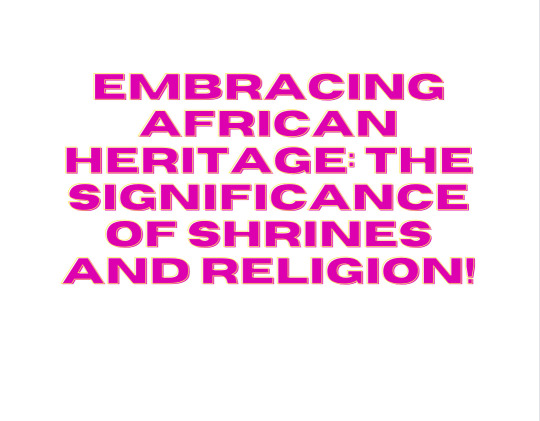
Embracing African Heritage: The Significance of Shrines and Religion
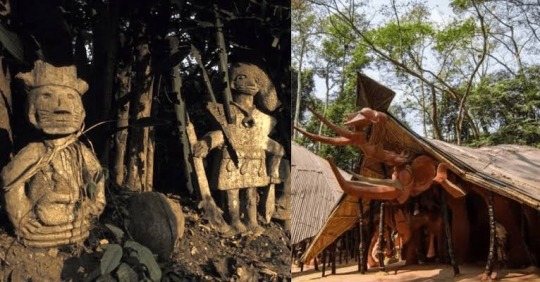
Africa, often referred to as the cradle of humanity, boasts a rich tapestry of cultures, traditions, and spiritual beliefs that have endured for millennia. Central to this heritage are the sacred shrines and profound religious practices that serve as pillars of community, identity, and connection to the divine.
Shrines, both natural and constructed, hold a special place in African spirituality. These sites are often nestled in the heart of communities or hidden within the vast landscapes of the continent. From the iconic pyramids of Egypt to the humble groves of the Yoruba in Nigeria, each shrine reflects a unique blend of history, mythology, and reverence for the ancestors.
One of the fundamental aspects of African religion is the veneration of ancestors. Ancestral shrines serve as focal points for prayers, offerings, and rituals aimed at honoring those who came before. These ancestors are believed to possess wisdom, guidance, and protection, and their spirits are invoked for blessings and assistance in times of need. In many African societies, the bond between the living and the dead is deeply cherished, with rituals and ceremonies reinforcing the interconnectedness of past, present, and future generations.
Moreover, African shrines are often associated with specific deities or spirits, each embodying different aspects of the natural world or human experience. Whether it's Oshun, the Yoruba goddess of love and fertility, or Anubis, the ancient Egyptian god of the afterlife, these divine entities are revered through elaborate ceremonies, dances, and sacrifices. Through these rituals, devotees seek communion with the divine and seek guidance in matters of health, prosperity, and spiritual growth.
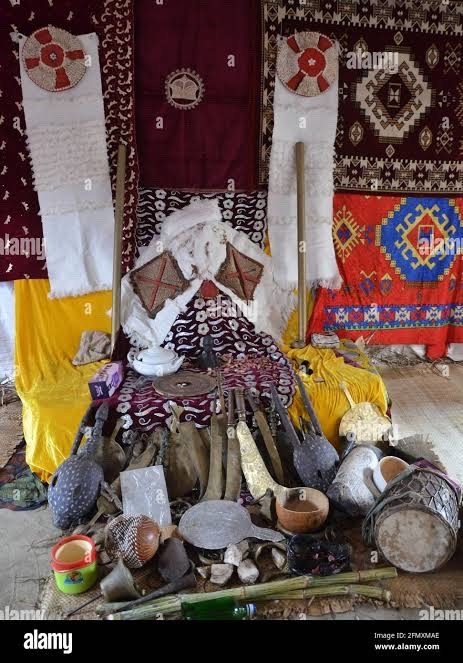
However, the significance of African shrines extends beyond the realm of spirituality. They are also repositories of cultural knowledge, oral traditions, and historical narratives passed down through generations. Within the sacred precincts of these sites, elders impart wisdom, storytellers weave tales of heroism and creation, and artists imbue their craft with symbols and motifs that speak to the essence of African identity.
Unfortunately, the colonial era and the spread of Christianity and Islam have often marginalized indigenous African religions, dismissing them as primitive or pagan. Despite this, many communities continue to uphold their traditional beliefs, adapting them to the challenges of modernity while preserving their core values and rituals. In recent years, there has been a renewed interest in African spirituality, fueled by a desire to reclaim cultural heritage and reconnect with ancestral roots.

In conclusion, African shrines and religion embody the resilience, diversity, and spirituality of the continent's people. They are more than just places of worship; they are living testaments to the enduring legacy of Africa's past and the enduring power of its traditions. As we navigate an increasingly interconnected world, embracing and honoring Africa's rich heritage is not only a matter of cultural preservation but also a celebration of the human spirit's boundless capacity for faith, creativity, and reverence for the divine.
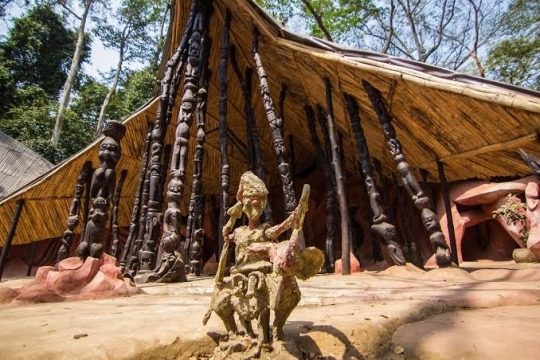
#life#animals#culture#aesthetic#black history#history#blm blacklivesmatter#anime and manga#architecture#black community
63 notes
·
View notes
Text

Posted: 2/11/25
The Enchanting History of Love Magic Across Cultures
February has arrived with its whisper of roses, chocolates, and declarations of affection, the air is charged with the promises of love. Valentine's Day (Feb. 14th), though modern in its commercial veneer, is steeped in traditions that reach deep into human history. Among these, the practice of love magic—rituals, spells, and charms to attract, secure, or mend love—has traversed cultures, continents, and centuries. Let us embark on a journey to uncover how African, the African diaspora, Indigenous American, Asian, and European traditions have woven love magic into the tapestry of their spiritual and cultural practices.
Africa: Love and Spiritual Power Intertwined
In many African cultures, love magic reflects the profound connection between the spiritual and the mundane. Among the Yoruba people of Nigeria, practitioners of Ifá divination often called upon the Orisha Osun (Oshun) for love, beauty, and fertility. Offerings of honey, cowrie shells, and fresh water were made to Osun to invoke her blessings for harmonious relationships or to rekindle fading passion.
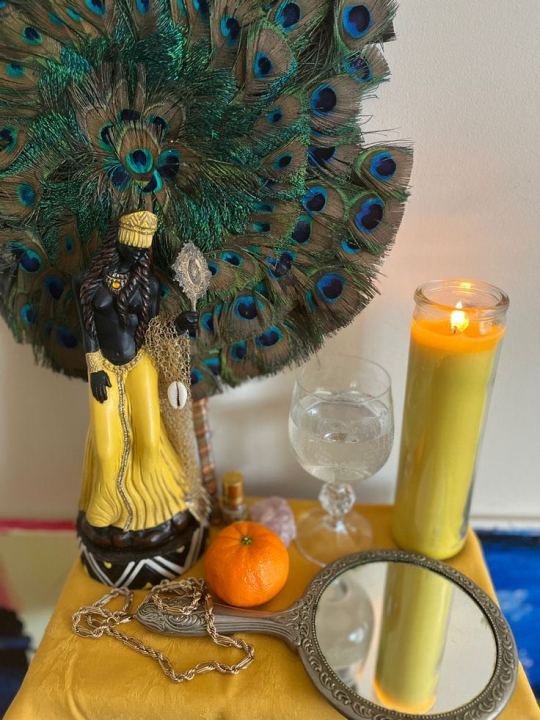
Meanwhile, across the continent, the use of botanicals for love magic was also widespread. In South Africa, for example, Sangomas (traditional healers) used herbs like "Umavumbuka" to foster reconciliation, harmony and emotional healing. These rituals often reflected the belief that love and harmony within relationships were essential for community balance, weaving personal desire into collective well-being.
African Diaspora: Love Magic in Survival and Resistance
As the African diaspora spread through the transatlantic middle passage, love magic was adapted and evolved within the crucible of multiple new environments. In the Americas, Hoodoo—an African American spiritual tradition—emerged, integrating African, Indigenous, Jewish and European influences. Practitioners used "mojo bags" filled with herbs, roots like John the Conqueror or Queen Elizabeth root and other personal items, powders or oils to draw love or fidelity. Honey jars, a sweetening spell to encourage affection and harmony, remain popular in contemporary Hoodoo practices.

In the Caribbean, Vodou and Obeah intertwined African cosmologies with local and European influences. In Haitian Vodou, for instance, Erzulie Freda, the lwa (spirit) of love and beauty, was and is still often petitioned for matters of the heart. Her rituals often included perfumes, pink and white candles, and luxurious offerings symbolizing sensual pleasure and emotional depth.
Global Indigenous Cultures: Love Magic in Harmony with Nature
For many Indigenous American cultures, love magic was less about control and more about alignment with natural energies. Among the Navajo, for instance, "beautyway" ceremonies invoked harmony and balance, which also extended to relationships. Love charms crafted from turquoise, or shells were believed to attract a compatible partner, resonating with the spiritual properties of these materials.
The Cherokee practiced rituals to strengthen bonds between lovers or to resolve conflicts. Songs, dances, and natural elements—such as cedar or sage—were integral to these ceremonies, symbolizing purification and renewal.
Indigenous peoples outside the Americas also have their own rich traditions of love magic. Among the Sami people of Scandinavia, noaidi (shamans) practiced rituals that included the use of drums and joik (a traditional form of song) to invoke spiritual assistance in matters of love and relationships. These practices were deeply tied to the natural cycles and spirits of the Nordic landscape.

In South America, the Quechua and Aymara peoples of the Andes incorporated love magic into their spiritual practices. Coca leaves, a sacred plant, were often used in divination to seek guidance about romantic relationships or to attract a desired partner. Rituals performed at sacred sites, such as mountains or lakes, were believed to align the participants with Pachamama (Mother Earth) to ensure harmony in love.
Indigenous Australian cultures often intertwined love magic with Dreamtime stories, the spiritual and temporal framework of their worldview. Rituals might have included sand drawings, chants, and symbolic offerings to attract or strengthen love, aligning the participants with the ancestral energies of the land.
Asia: The Alchemy of Love
Asian cultures have also long embraced love magic, often blending it with spiritual and philosophical traditions. In China, Taoist love spells focused on harmonizing yin and yang energies within partnerships. Charms inscribed with auspicious characters or infused with essential oils were used to attract romantic opportunities or sustain marital bliss.
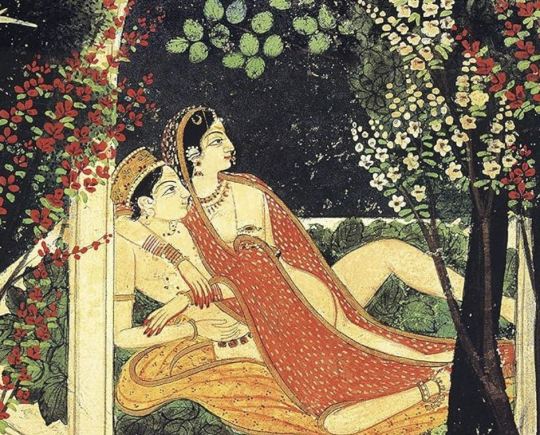
In India, the Kama Sutra, more than a manual of intimacy, delved into rituals and practices for fostering love and attraction. Ayurveda, India’s ancient medicinal system, recommended aphrodisiac herbs like ashwagandha and shatavari to enhance passion and deepen emotional connection.
Japanese folklore, on the other hand, speaks of "omamori" love talismans blessed at Shinto shrines. These were carried to invoke the protection and favor of kami (deities) for romantic endeavors.
Europe: Spells of Romance and Obsession
Europe’s history of love magic is a blend of folklore, mysticism, and religious undertones. In ancient Greece and Rome, love potions—often made from herbs like myrtle or rose—were crafted to awaken desire. Aphrodite (or Venus), the goddess of love, was frequently invoked in rituals, with offerings of doves or apples symbolizing beauty and fertility.

During the medieval and Renaissance periods, love magic often walked a fine line between fascination and persecution. The use of "philters" (love potions) and "poppets" (dolls) to influence romantic outcomes could lead to accusations of witchcraft. Yet, folk practices persisted. For instance, English cunning folk recommended carrying rose quartz to attract love, while French peasants relied on charms sewn into clothing to inspire fidelity.
Love Magic Today: A Universal Language
Despite its varied expressions, love magic is a universal thread linking humanity’s longing for connection. In modern times, these ancient traditions continue to inspire spiritual practices. From lighting candles on Valentine’s Day to crafting intention spells, the essence of love magic endures—reminding us that love is as much a spiritual endeavor as it is an emotional one.
This Valentine’s Day, whether you light a candle, gift a rose, or simply reflect on the magic of love, remember: across every culture and era, love has been a force worth invoking, celebrating, and cherishing.

Bibliography : Yoruba Religion and African Spiritual Practices: Drewal, H. J. (2009). Yoruba: Nine Centuries of African Art and Thought. Hoodoo and Vodou Traditions: Anderson, J. L. (2008). Conjure in African American Society. Indigenous American Rituals: Johnston, B. (1976). Ojibway Ceremonies. Asian Love Magic: Needham, J. (1956). Science and Civilisation in China. European Folk Practices: Kieckhefer, R. (1997). Magic in the Middle Ages. Indigenous Traditions in Australia and Scandinavia: Pentikäinen, J. (1996). Shamanism and Culture. Andean Spiritual Practices: Bastien, J. W. (1985). Mountain of the Condor: Metaphor and Ritual in an Andean Ayllu.
#history of love magic#love magic#the love witch#aphrodite#hellenic polytheism#hellenic deities#hellenic worship#karma sutra#the lovers#valentines day#Oshun#african traditional religons#hoodoo#haitianvodou#erzulie freda#love spells#february 2025#witchblr#pagan community#venus#brujeria#witches of color#magic#history#indigenous#south america#folk magic#america#european#asia
14 notes
·
View notes